





What is a Jew?
Jews: A Race? A Historically-Inbred Ethnic
Group? A Religion? Or All Three?
Are Jews a race? Yes...and no. Yes, they are
people related by DNA or genes. But most anthropologists do not classify Jews as
a race, or a subrace, since a) Ashkenazim Jews, i.e. most, Jews are a racial
hybrid, and b) calling Jews anything other than a religion has been taboo since
WWII. Further, that question "are Jews a race?" depends on the/your scientific
definition of the word "race" [subspecies]. The term "ethnic group" is probably
more accurate in describing the Jew, although "race" can also be used.
[A word needs to be said about the field of
Anthropology and Jews. An anthropologist informed us that when he studied
anthropology in the 1950s, Jews were not referred to as anything other than a
religion, and he said that that feature is still true today. We call this
non-mention of Jews as an ethnic group by the anthropology field dishonest and
politically-motivated].
Someone on the web mentioned that [paraphrasing]
"Jews function as a race, so they are a race, regardless of what modern science
calls them." Indeed. Jews are more cohesive and unified than any other ethnic
group, so that is a great description of the Jews. Thanks, somebody.
Furthermore, the word "White" means White
European. In other words, a White person's ancestors originally came from a
White European country, such as England, Germany, France, etc. Some Jews may
appear to be White. In other words, they may have light-colored skin and
light-colored hair. That does not make them White, however. Only genetics makes
a person White. The Jews are not genetically White. [One of the reasons that
the Jews have been so successful in the Western countries is that they sometimes
appear to be White].
White gentiles should hopefully be able to
recognize Jewish people based upon their physical appearance, but granted, this
is not always possible. However, Jews often have features that identify them as
being Jewish by race. The majority of Jews do share common physical features --
especially in their faces and/or craniums [skulls].
Brief History of the Jews
Jews originally came from the tribe of
Judah/Judahites back in old Canaan or Palestine. The Judah tribe was banished
from the other Israelite tribes in about 950 BC. In 70 AD, the Romans destroyed
Jerusalem, and did so again in 134 AD, compelling Jews as a people to scatter in
the wind. Some of those Jews made their way to Europe, others stayed closer to
their original homeland.
There are two main types of Jews. Most Jews in America and Europe are Ashkenazim, aka "Eastern European" or "Russian" Jews.

Typical Jewish appearance: large nose
that curves downward, weak chin, sloped
forehead, 'pinched' facial appearance

Typical Jewish appearance, including large
ears that protrude away from the head and a
heavy, 'fleshy-looking' face. Some people in
the White Nationalist movement have called this
traditional Jewish facial appearance "rodent-like,"
although some Whites may find that description
tasteless

Above: typical Jewish nose, curving downward at
the tip
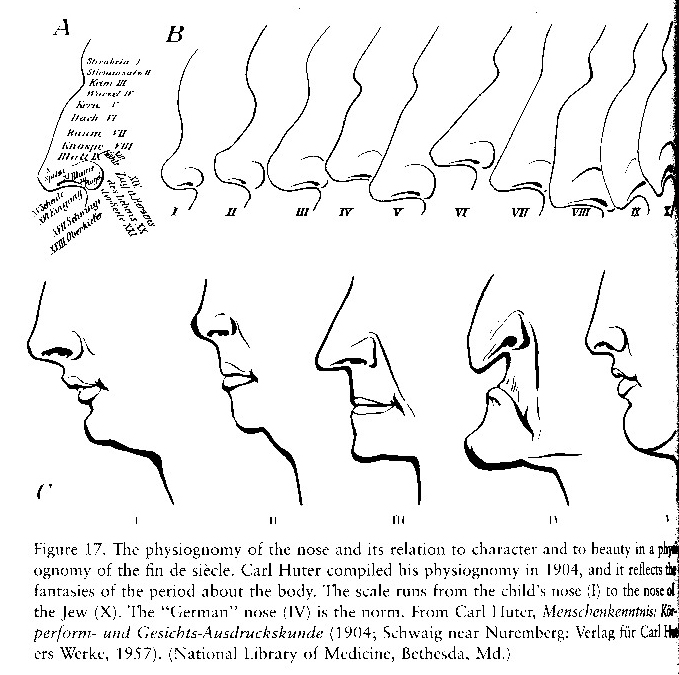
Ashkenazim Jews are a hybrid race by long interbreeding, their major ethnicities being Arab + Armenid [Armenid is also sometimes called Hittite or Subarian]. According to Oxford University's Dr. John R. Baker, "the evidence from blood-groups bears on the theory that the Ashkenazim have both Armenids and Orientalids ["Orientalids" is Dr. Baker's word for Arabs] for ancestors." -- from Baker's book Race, [see below], page 242, hardcover.
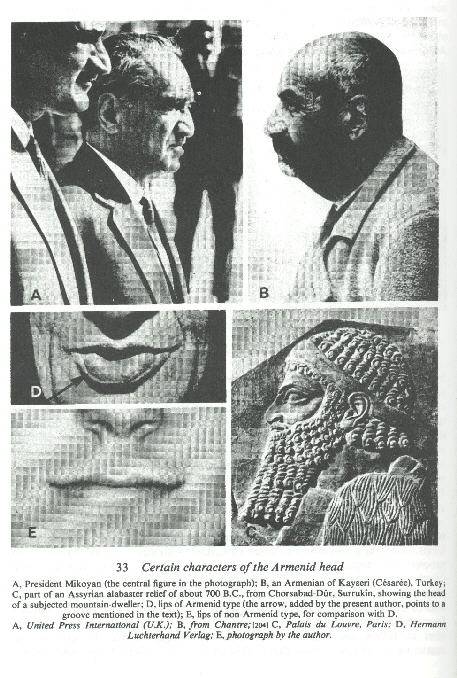
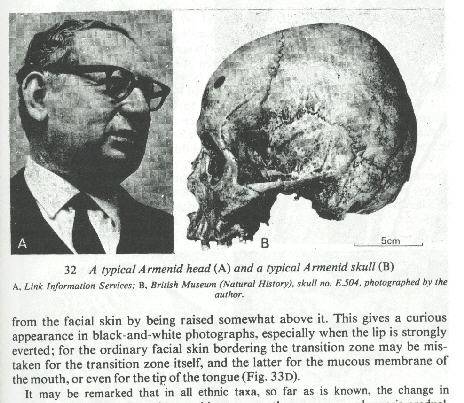
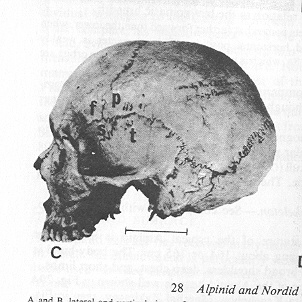
Compare White skull above to Armenid/Jewish skull -- White skull has longer
rear portion, whereas Armenid/Jew skull looks as if the back of the head were
"sawed-off."
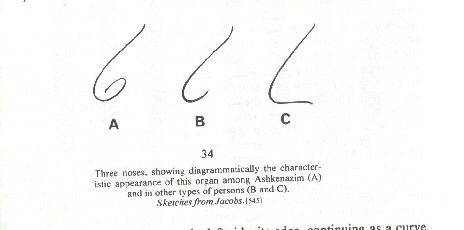
The other, comparatively rarer type of Jew is
the Sephardim, also known as "Mediterranean," or "Spanish," or "Portuguese," or
"North African" Jews. These Jews lived mostly near the Mediterranean Sea.
Sephardim Jews also lived in Iraq (Babylon), Syria, Greece, Turkey, and in the
Americas, especially South America. Furthermore, Sephardic Jews lived in
Palestine long before the European Zionist movement. Only about 10% of all Jews
worldwide are Sephardim; the rest are Ashkenazim. Sephardim are more closely
related to Arabs, while Ashkenazim are more related to
Armenids/Hittites/Assyrians.
According to Dr. Baker, "when it is said that a
person has a Jewish appearance, the speaker usually has persons of Ashkenazic
stock in mind. The members of this group are the typical Jews of Russia, Poland,
and England, and they constitute the great majority, perhaps 90%, of all the
people in the world to whom the name of Jews is applied." -- from Race,
page 238, hardcover.
In 1492, Jews were expelled from Spain. Portugal
expelled her Jews five years later. Some Spanish and Portuguese Jews converted
to Christianity, and these Jews were referred to as "Marranos" by Jews who had
left Spain/Portugal but kept their faith. Later, as the new converts began to
gain power and social status, these "New Christians" become suspect by the "Old
Christians" in Spanish society as being insincere converts. They were then
called Crypto Jews, or Anusim -- Jews who still practiced Judaism in secret.
It is the opinion of many gentiles that there
are many Crypto or Marrano -- also called "converso" -- Jews in positions of
power all over the West, but that few gentiles know of these hidden Jews' real
ethnic heritage.
Despite their geographical dispersion, however,
all Jews are genetically similar to a remarkable degree, given their diaspora
and the chance, seldom taken, to mix blood with surrounding populations.
[Also of note is that a U.N.-sponsored body
listed "Jewish" as being only a religion in 1951 -- no doubt for political
purposes, since WWII had just ended a few years previously. John Baker shows
that Jews are indeed an ethnic group related by race, although he says that they
are not a subrace since some people of Armenid descent are not Jewish].
The question "who is a Jew?" has a simple
answer: anyone whose birth mother was Jewish by race -- i.e., not a convert to
Judaism; or, cleverly, the few people who convert to Judaism. Under Israel's Law
of Return [1], a gentile who converts to Judaism can immigrate to Israel.
However, conversion to Judaism is rare and difficult by design, and such
converts are not considered to be "true Jews." It is the opinion of many that
Jews "allow" converts so as to make Jews appear, to outsiders, to be "not a
race, only a religion." Such a feature also allows Jews to deflect the charge
that Israel is "a race-based state."
[1] quote from Israel's amended Law of Return:
"Definition 4B. For the purposes of this Law, "Jew" means a person who was born
of a Jewish mother or has become converted to Judaism and who is not a member of
another religion." -- Law of Return (Amendment No. 2) 5730-1970*; Addition of
sections 4A and 4B apparently occurred in 1970.
------------------------------------------
Facial/Cranial Features of Ashkenazim Jews
[Note that not all Jews have the physical features listed below]
A) Ashkenazim Jews have a long, large nose --
one that differs from Italian-type noses by the fact that it often curves
downward at the tip; the nose often has a noticeable "hump" on the top portion
of it, if viewed in profile; the nose often resembles the number "6," if viewed
with the grooves of the "wings" of the nose, in profile [2]. Further, some
gentiles have commented that Jews often have a facial appearance that seems
"pinched," as if God had taken their faces between his thumb and fingers and
then squeezed.
B) The forehead and temples of the skull recede
quickly. In other words, the forehead and temples begin to slope or curve almost
immediately, whereas in Whites those areas are more "wall-like" and vertical.
Studies of Jewish skull shapes show that most Jews are either a) not Semitic; or
b) only partly Semitic. Instead, they are Armenid/Hittite in their skull shapes
[3]. This means that the term "anti-Semitism" does not really apply to Jews
[also 3]. Further, many Ashkenazim Jews have short heads, as compared to
Europeans.
C) The ears of Ashkenazim Jews are usually
larger than a gentile's, especially the upper ear, and the ears often stick out,
away from the head; this, combined with their large noses, often gives Jews a
"rat-like" or "rodent-like" appearance. This "rodent-like" appearance is more
noticeable when they smile.
D) Mouth opening/lips often larger than normal.
E) The eyes are sometimes slightly Asian in
appearance, i.e. slightly more "squinted" than a European's. This is more
noticeable when they smile, squeezing their eyes shut even more than a
gentile's. Eyelids, especially the lower ones, are more puffed-out and "fleshy"
than a European's.
F) Jews usually have a "weak chin" that does not
jut out.
G) Jews usually have legs and arms that are,
proportionately speaking, rather short.
H) Their head hair is usually curlier, and
darker, than a gentiles; further, Jews often cannot grow heavy beards; their
beards are often scraggly and frizzy instead.
[1] source: book Race, by Dr. John R.
Baker, Oxford University Press/FHU; 1974/1981; pages 232ff, hardcover. This book
is considered by many to be the most detailed book ever written about the
various human races. It includes many photos and diagrams.
[2] "Luschan holds that the hook-nose is by no
means characteristic of the Semites, and contends that the number of arched
noses that are found among the Jews is due to ancient intermixture with the
Hittites in Asia Minor. He shows that other races also, as the Armenian, for
instance, who have a good portion of Hittite blood in their veins, have
hook-noses" (Jewish Encyclopedia IX [1905], 338). Also: "The relation of the
breadth of the nose to its length, known as the 'nasal index,' has been
considered one of the best means of distinguishing the various races of
mankind." (Jew. Enc. IX [1905], 339). And, "The nose is generally the
characteristic feature of the Jews, who have, on the average, the longest (77
ram) and narrowest (34 mm)" (Jew. Enc. I [1901], 619).
[3] "The most important problem suggested by a study of craniometrical results concerning Jews is the relation of the type head of the modern Jews to that of the ancient Hebrews and to the modern Semitic skulls. The pure Semitic skull is dolichocephalic [long-headed], as may be seen from a study of the heads of modern Arabs, Abyssinians, Syrians .... The only way the type of the head may change is by intermixture with other races. If the ancient Hebrews were of the same stock as the modern non-Jewish Semites, and if the modern Jews are their descendants, then a pure dolichocephalic type of head would be expected among the Jews. As has been seen, all results of craniometry prove that the Jews are brachycephalic [broad-headed], and that the dolichocephalic form is only found among them in less than two percent of the cases" (Jewish Encyclopedia IV [1902], 335). Also, "Some anthropologists are inclined to associate the racial origins of the Jews, not with the Semites, whose language they adopted, but with the Armenians and Hittites of Mesopotamia, whose broad skulls and cuffed noses they appear to have inherited" (Jew. Enc. X [1903], 264). Dr. John Baker's modern book Race also calls Jews brachycephalic instead of dolichocephalic.
